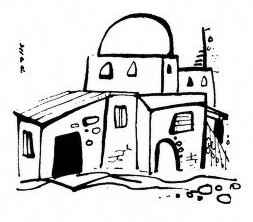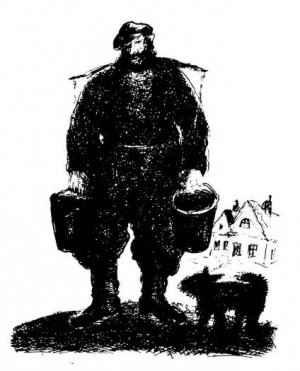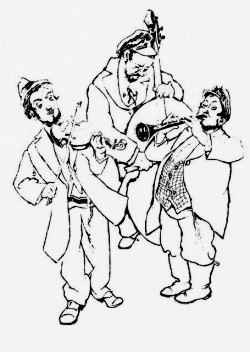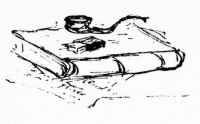
|
|
[Page 29 – English]

After the 1831 Revolt
After the Polish revolt of 1831 was crushed, the independent Poland ceased to exist, and in March, 1832, Poland became Russian territory. In the wake of the Russian Army, which came to crush the revolt, a catastrophe occurred, which hit the population of Poland badly: Cholera epidemic broke out and raged in Poland for over one and half years. It claimed many victims also from amongst the Jews of Ostrowiec, and is registered in the annals of the town as one of its severest disasters.

|
In 1863, the second Polish revolt broke out, occasioned this time by the order of general mobilization of the Polish youths, aimed at silencing their efforts of freeing themselves from the Russian yoke. The Ostrowiec Jews did not hesitate to help the rebels with food supplies and transportation of arms. It is known that R' Leibush, the Tsadik of Lipsk (near Ostrowiec), (the son of R' Yehiel Pessach Primer), chose Ostrowiec as his seat. He was in contact with the nobles and the leaders of the Polish revolt, who asked for his intervention with the Jews
[Page 30 – English]
so that the latter should help the rebels against the Russian army. The Rabbi from Lipsk collected money and clothing at Ostrowiec, and made the tailors of Ozarow and Tarla-Solin sew uniforms for the rebels. After the big battle in the vicinity, which ended in the defeat of the rebels, persecutions started against the Jews at the instigation of some slanderers. At Ozarow one slanderer was put to death by the tailors: they brought him forcibly to the forest and clubbed him to death. The help of the Jews from Ostrowiec and vicinity to the rebels impressed the Poles considerably. A Polish nobleman's wife, descendant of the royalty, donated a gold-embroidered curtain for the Ark of the Law of the Ostrowiec Synagogue. The elders of the town remembered well her initials – P.R. – embroidered on the gift. To avoid the evil eye, during the entire period of Russian domination, the curtain was not in use. When Poland was finally liberated, the curtain was taken out of its hiding place and served on holidays, when it was used as a symbol of the good relations between the Jews and the Poles of the region.

The Jewish masons helped also in the construction of the churches. The priests of the vicinity were preaching for peace with Jews, and even praised the Jews for their help during the revolt. Some of the priests had Jewish tailors to whom they stuck permanently. This idyllic co-existence of the two parts of population lasted until 1896, when the Catholic Church began to preach against the Jews, and the peaceful life of the Ostrowiec Jews deteriorated gradually.

At Crossroads at the End of the 19th Century
The Ostrowiec Jews derived their livelihood from 3 sources: firstly, from the big steel and iron works, which gave employment to about 10,000 workers, who would spend their wages at the town's shops, the shop-keepers affording them
[Page 31- English]
credit on account of their future wages. The second source was the market days, which were held in town since many years, by royal order or by the order of the founders of the town, even before the partition of Poland. In Ostrowiec market-days were Mondays and Thursdays. The peasants from the neighbouring villages would assemble with their carts full of agricultural produce, and on their way back they would be loaded with goods bought in town against their earnings, realized from sale of their produce. The third source was – in later periods, -- the American dollars that would come regularly from relatives, who emigrated to the States and Canada.
To these 3 sources of income must be added the profession of religious ministrants, who obtained their salary from the community, and the peddlers who carried their merchandise from door to door all over the villages, and the craftsmen who lived from the town people and the peasants around it. Every Sunday morning, they used to hoist their bundles of utensils on their backs and, at sunrise, leave on their errand in the villages. The peddler would wander from village to village, or from fair to fair, for all the days of the week, saving on his food, to be able to bring home a few zlotys for the Sabbath with his family. Among the merchants, a few managed to get rich. The small merchant's situation was anyhow better than that of the peddler and also better than that of the 'permanently occupied' like the 'melamedim', the scribes of scrolls, phylacteries and mezuzoth, clerks, etc. Also people who lived from undefined deals, like go-betweens, arbitrators, match-makers and others, should be added. Ostrowiec did not differ from the other Jewish towns of Congress Poland in this respect.
|
|
In 1888, a young genius came to Ostrowiec and submitted his candidacy for chairmanship of the court. This prodigy, Rabbi Meir Yehiel Halevy Halstock, nominated the town Rabbi, became in time the outstanding personality of the generation, rendering all the Jews of his town
[Page 32 – English]
proud of his righteousness and fame within the Jewish world.
As a result of slander, Rabbi Meir Yehiel had to pass Russian language proficiency examinations, in order to be entitled to serve as Rabbi 'on behalf'. In a few weeks he mastered the language and successfully passed the test of proficiency in Russian. In the days of birth of the country, he had several opportunities to meet the officials of the central and local government, to perform a prayer, blessing the Tsar, in the synagogue in the presence of representatives of government, and to shake hands with them. Immediately thereafter he would hurry to the 'Mikve' to dip in it and wash himself of the filth which was left on his body after the contact with the unclean civil servants.
Once there was established in Ostrowiec a company of Jewish soldiers who formerly served in the Tsar's army, and who wanted to be called Soldiers' Company. On the eve of bringing the Holy Scriptures into their synagogue, they invited Rabbi Meir Yehiel to join in their celebration. The Rabbi did not like the name of the new society and suggested they call themselves 'Shomrei Shabbath' (Keepers of the Sabbath). Thereupon he was asked if he doubted their observance of the Sabbath; he answered he needed their help in watching that the shopkeepers and peddlers at the marketplace should close their stands in time without breaking the Sabbath. The ex-soldiers accepted the task of urging the shopkeepers to close their shops, before the advent of the Sabbath.
|
|
The Jews were busy with their work in daytime, while in the evenings they read the Torah. After eking out their living, their entire devotion went to the study of the Torah and the belief in better life in the world beyond. The women brought up their children and the craftsmen – tailors and shoemakers – clad and shoed the townspeople and the surrounding population.
The Beginnings of the 20th Century and its Changes
Up to the end of the 19th century, the Jews of the town lived in complete loyalty to tradition, and nobody dared to imagine that it was possible to deviate from what was the custom for generation on end. The town was a fortress of the Jew-
[Page 33 – English]
ish tradition. The community was generally unanimous, but sometimes differences of opinion would arise in connection with the old 'Hazan' and the new one. The small beth-hamidrash competed with the new, the new beth-hamidrash – with the old, and the two together competed with the synagogue, which looked on condescendingly on whoever passed along, hurrying, not to let anybody else outdo him.
The Jewish town did not come into being at once; it formed itself for long generations. There was the market square in the middle, with shops and stands, and business places all around it, and houses that passed in heritage from generation to generation, to sons and to grandsons, who lived and grew up in them, married and continued their Jewish life. All around the market place wound themselves the Jewish streets, with names like Apt Street, Konow Street, Drildz Street, Szenna Street, Market Street, Minzberg Street, and so on. The streets were all inhabited by Hassidim, pupils, merchants, Rabbis, wise men, butchers, prodigies and just Jews.
The Jews led their specific way of life fearlessly and proudly – in days of joy and in times of sorrow. They used to hold their weddings in the courtyard of the synagogue, under the open sky, and their funerals they led across the market place. On Sabbath eve the 'shamash' (usher) would announce the Sabbath with the sundown, in that he knocked on doors of the wealthy shops and barbers' who were not in a hurry to close their business, although the sun was sinking. At the entrance to town, the 'Eruv' (Sabbath limit) was checked, which delineated the borders of the holy congregation. On Saturdays and during holidays, the whole town looked quite different, with all its shops closed and the festive atmosphere pervading every nook and corner of the Jewish Ostrowiec.
Up to the First World War no change occurred in the way of Jewish upbringing, which went on according to tradition, hundreds of years old. The boys used to start learning the alphabet from the elementary teachers. Then they passed on to the 'Melamed' who taught them Pentateuch with RASHI (interpretation). Later they would study Gemara, starting with the 'four primary causes of injury', all through the tractates of Baba Kama, Baba Meziya, Kidushin, then they went on to the more difficult tractates, like the Oaths with the interpretation of Haran; to the interpretation of the supplements and to the Yore De'ah (one of the four parts of the Shulkhan Arukh). In every house-of-prayer in town there was a room for infants and children. At the Stibl's the boys continued studying in groups 'Tonu Rabanan' and 'Amar Avii'
|
|
[Page 34 – English]
in the special manner of sing-song which used to be passed on from generation to generation. Also the way in which the infants were brought up was unchanged for ages: Torah paragraphs translated into Yiddish were sung by choirs of children and their recitative burst out of the open windows in summer and even out of the closed windows in the cold winters. In cold winter evenings boys would walk home from their 'Heder' with lamps in their lands, while the snow would rustle under their feet to the tune of their songs. The melody of the Torah study at the Heder entered the Jewish heart and healed the soul. Even more wonderful was the reading of the weekly paragraph in the customary measure, every single Friday – as wonderful indeed as the taste of fresh rolls with meat on Fridays sauce, which never tasted the same on other days of the week. The sound of the mortar and the smell of the spices, and the fish cooking slowly, were the announcers of the Sabbath-Queen's arrival.
The townspeople, and especially the Hassidim, knew how to apply the Sabbath rest to the enjoyment of the prayers and the meals of Sabbath, the afternoon
|
|
[Page 35 – English]
sleep, the tasting of wine and of sweets, the sermon of the 'Magid', the public, third repast, and finally – the fourth meal (eaten at the conclusion of the Sabbath) in company, with stories about the Baal Shem Tov and his pupils.
Thus the town celebrated Sabbath and holidays. Every Jewish home was an inn for the Sabbath Queen, whether it was a modest room of a peddler or a craftsman, or the living room of a rich man, a hut of an ignorant man or the house of a learned man, versed in Torah and descended of Rabbis and wise men.
In the synagogue, in front of the Ark, would pass the Hazanim and the praying men singing in lovely voices. Many of the elders still remember the famous old Hazan R' Meirl, of the Worka Hassidim, who was handsome of face and wore a patriarchal beard. After he served for many tens of years in t his character and the praying men were aware of the fact that his voice was no more as it used to be, and that he does not merit any more to stay in office as Hazan, they nominated in his stead Moshe Wohlman, who introduced the singing of prayers in a choir form. There were some good Hazanim in the Beth-Hamidrash and also in
|
|
Most of those appearing on the photograph were “liquidated” |
[Page 36 – English]
The 'Stibl's because of whom they sometimes became famous.
This was roughly the time when the spirit of the Haskalah (Enlightenment) penetrated the Beth-Hamidrash walls and reached its pupils. Some of them used even to hide underneath the Gemarah 'forbidden books' like Peretz Smolenski's and Abraham Mapu's books. Even copies of 'Hatsefira' could be seen amongst the pupils who swallowed with zeal the words of Nahum Sokolov's articles. But this breeze was not enough to cause the boys to closed their Gemarah volumes and start striving towards the 'light and space' envisaged by the Enlightenment.
The imprint of Jewishness was noticeable not only during the Sabbath days but during the weekdays as well. Amongst the Jews there were some who were tall and presentable, mostly they were the synagogue-Jews, wise and learned, from good families, merchants, industrialists, businessmen and craftsmen, Melamdim, Rabbis, butchers and other religious ministrants in whom every Jewish township abounds. They had heart and soul, and the special Jewish cleverness and a soft manner of speech and politeness. There were also fanatic and exact Jews, severe 'Kozacks of God' – with a holy fire in their eyes, of serious behavior in negotiations as well as in habits of eating and drink.
There were also generous Jews, and Jews repaying good in full, whose generous help and donations achieved for them fame in the entire region; they did not consider their job or livelihood as the aim of their existence. They aspired to self-improvement and sublimation. But also the vain people of the town and the hooligans, who were few in numbers, often controlled their tempers and proved their devotion to their brethren when Jewish life and welfare were in peril.
The youths of Ostrowiec were not afraid of the Gentiles in town. They knew how to defend themselves and hit back when hit. Between the Jewish youths and the Gentile youths of the 'Hill', on their way home stone-throwing battles were led, over many years, although no one of the two parties to it knew what caused it.
|
|
JewishGen, Inc. makes no representations regarding the accuracy of
the translation. The reader may wish to refer to the original material
for verification.
JewishGen is not responsible for inaccuracies or omissions in the original work and cannot rewrite or edit the text to correct inaccuracies and/or omissions.
Our mission is to produce a translation of the original work and we cannot verify the accuracy of statements or alter facts cited.
 Ostrowiec Świętokrzyski, Poland
Ostrowiec Świętokrzyski, Poland
 Yizkor Book Project
Yizkor Book Project
 JewishGen Home Page
JewishGen Home Page
Copyright © 1999-2026 by JewishGen, Inc.
Updated 16 Jul 2023 by LA